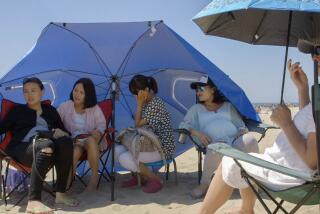Expectant Mothers Take Superstitions Seriously
Phyllis Mourhess was well along in her pregnancy when a baby with a deformity was brought into the hospital nursery where she worked.
âA nurseâs aide warned me against treating, even holding that deformed baby for fear my own child would also be deformed.â
Mourhess, now head nurse in the labor and delivery room at St. Johns Hospital and Health Center in Santa Monica, took the risk, even after the aide insisted a baby in the womb could be marked by fearful or ugly things the mother saw or touched.
Many Similar Beliefs
A veteran of 25 years in obstetrics wards, Mourhess can recall dozens of similar beliefs about pregnancy and birth shared by some nurses and patients alike.
Few of these popular beliefs have any basis in medical reality, according to Dr. Charles Brinkman, chief of obstetrics at UCLA Medical Center. âStill you run into them all the time,â he said.
âYou would think that with all their scientific training, nurses and doctors would overthrow the popular beliefs learned earlier in their lives,â said Sondra Thiederman Ph.D., a former nurse and now a San Diego consultant to hospitals on the treatment of people from a variety of cultures.
âBecause of our need and desire to control the uncontrollable, we need popular beliefs,â Thiederman said.
Medicine still has much to learn about the magical mystery tour from conception to birth, she explained. It is in the gaps of medical knowledge that popular belief and ritual flourish, fulfilling an important psychological function.
The notion that the full moon triggers births was the most frequently encountered popular belief among nurses in a series of interviews, although Brinkman said it has no scientific validity.
Almost as many nurses insisted delivery rooms get busy when it rains or when there are major weather changes--another widespread belief with no scientific foundation.
Bad Weather Babies
âIâve heard that babies come when there are high winds, Santa Anas or changes in barometric pressure,â said Lucy Negin, a postpartum nurse at St. Bernardineâs Medical Center in San Bernardino.
Pat Clinton, coordinator of maternal and child-care outreach at St. Joseph Medical Center, Burbank, recalled: âI was working at Cedars in â71 at the time of the big earthquake and I swear everybody went into labor.â
A pregnant womanâs cravings for food can be especially important, according to some folk beliefs. If the mother ignores the craving, the belief is that the baby will drool all the time, said Zenaida Cabudol, the obstetrics supervisor at East Los Angeles Doctors Hospital.
And nurses from East Los Angeles, the San Fernando Valley and Inglewood recalled warnings not to eat strawberries lest the baby be born with a strawberry birth mark.
Mothers, too, are said to be vulnerable during pregnancy. Many hairdressers dislike giving permanents to pregnant women, Clinton recalled, for fear the motherâs hair will fall out.
But if the child in utero can be harmed, it can also be helped.
âA lot of mothers will play classical music to soothe the fetus,â Mary Winton, a labor and delivery nurse at St. Joseph, noted.
While pregnant herself, Winton went to a Sha Na Na concert. Her baby boogied, she said, adding, âThe baby knows. The baby hears.â
Sensitive Fetus
Brinkman agreed that the fetus is sensitive to both sound and light. In that case popular belief preceded medical knowledge, he said.
Similarly, âany granny (midwife) would have told you alcohol hurts the fetus, or at the very least will make the baby an alcoholic,â said Frances Cattermole-Tally, executive editor of the Encyclopedia of American Popular Beliefs and Superstitions at UCLA.
Alcohol, as well as cocaine and heroin, can âcause dismorphic changes in the fetus,â Brinkman concurred. âIt can cause malformations and can even affect the migration of neurons in the brain, causing a permanent deficit.â
Trial and error produced at least one widely known folk cure for morning sickness. Almost all of the nurses recommended one or two crackers before getting out of bed in the morning.
Patients commonly predict the babyâs sex by how the mother carries the fetus. Every one of the dozen nurses interviewed for this article had heard that if the mother carried high, in front or with a pointed abdomen she would deliver a boy. If she carried low, from side to side so that her hips spread, it was a girl.
Six of the nurses interviewed also believed that, as Carol Horch, administrative head nurse in the maternity ward at Valley Presbyterian Hospital in Van Nuys, put it, âYou can tell the sex of the unborn baby by the heartbeat.â
UCLAâs Brinkman was unconvinced. âIâve never seen any evidence of the scientific validity of that,â he said. âItâs an old wivesâ tale.â
Even more nurses had heard of various string tests in which a string or thread with a pencil or a ring tied to the end is dangled over the pregnant womanâs abdomen. If the pendulum swings back and forth, it is a boy; if it swings in a circle, the child will be a girl.
Four nurses mentioned the widespread practice in hospitals today of delaying the application of antiseptic ointment in the newbornâs eyes until after the mother and baby have bonded.
First Hour Crucial
âFor about one hour right after delivery, the baby is most awake, ready to bond with the mother. Then it goes into a sleep period of from four to 12 hours when it is hard to wake,â Horch said.
In that crucial first hour, some doctors and nurses insist, mother and child must see each other to firm the bond between them. Because the anti-gonococcal ointment blurs the childâs vision, nurses will often wait to put it in the infantâs eyes until the mother has held her newborn.
Many nurses and patients might be skeptical, Thiederman noted, but folk beliefs die hard and âit doesnât pay to take chances.â
More to Read
Sign up for Essential California
The most important California stories and recommendations in your inbox every morning.
You may occasionally receive promotional content from the Los Angeles Times.










